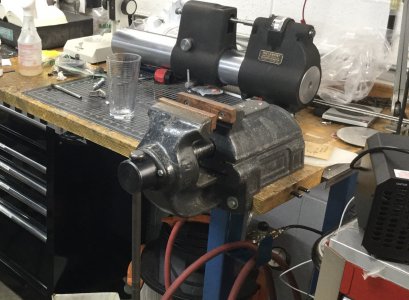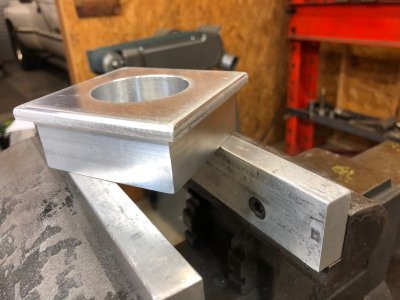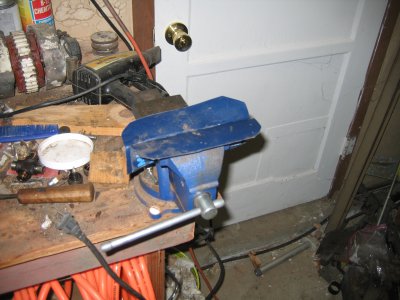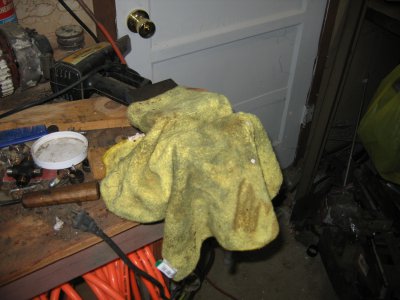Okay NC Rick - so what’s a ”vomit vice” ?My magnets went "south" after I used the Propane torch to heat something I was holding. I have the copper Wilton wrap jaws on my "big vise" aluminum jaws in an other and shop made copper replacement jaws in my "vomit vise".
I like smooth hardened steel jaws too.
-
Welcome back Guest! Did you know you can mentor other members here at H-M? If not, please check out our Relaunch of Hobby Machinist Mentoring Program!
You are using an out of date browser. It may not display this or other websites correctly.
You should upgrade or use an alternative browser.
You should upgrade or use an alternative browser.
Vise soft jaws
- Thread starter Aukai
- Start date
- Joined
- Sep 1, 2020
- Messages
- 794
Lol, I was baiting to be sure but it has its name for a reason. I think it is a Gressel but a German made Leinen type for sure. The vomit name comes from the dynamic jaw being the rear jaw and after using American vises often for so many years, I get vertigo looking at it when clamping a part. A friend of mine who owns a marine performance engine shop tried it and had the same reaction. A couple years on and I still have to look away while spinning the handle. Copper replacement jaws installed.


- Joined
- May 27, 2016
- Messages
- 3,469
That is a well known condition. The state of one's own movement relative to the visual frame of reference, and further, to then resolve movement of other stuff is a highly refined control system that relies on your eyes, and your inner ear motion sensors staying in agreement. If the local frame of reference starts moving without resolved feedback, you will feel ill!The vomit name comes from the dynamic jaw being the rear jaw and after using American vises often for so many years, I get vertigo looking at it when clamping a part. A friend of mine who owns a marine performance engine shop tried it and had the same reaction. A couple years on and I still have to look away while spinning the handle. Copper replacement jaws installed.
It is the same mechanism that gets you if you try to read a newspaper in a car while someone else is driving. The cues your body balance system is getting do not correspond to the eyes local frame of reference (the focus on the newspaper). A person in a boat pitching on the sea waves, being inside the hull without view of the horizon will also be prone (to vomit). A short-sighted or blind person in the back of a car - travel sickness. Try rolling over under a car, or washbasin without a neck support, and an upside down frame of reference of only the close-by surfaces.
Maybe you wear eyeglasses, and were face-up close to the vise dynamic surface, and could not really resolve that it was moving relative to the rest of your (mostly missing) frame of reference. The really bad condition that I once suffered was diplopia, "wandering eye". The mixed up images and wrecked vision were bad enough, but it came with that sick feeling. I was mighty relieved when a very clever medic knew the way to re-establish vision sync.
Getting it from being close up to a train when it pulls away is common enough, but this is the first I heard of getting it from the wrong vise jaw moving!
Last edited:
- Joined
- Sep 1, 2020
- Messages
- 794
Yep, always too strong of readers. I mention it because I think it is pretty funny. I'd freak out a little more when my rotary table keeps turning when I stop crankingThat is a well known condition. The state of one's own movement relative to the visual frame of reference, and further, to then resolve movement of other stuff is a highly refined control system that relies on your eyes, and your inner ear motion sensors staying in agreement. If the local frame of reference starts moving without resolved feedback, you will feel ill!
It is the same mechanism that gets you if you try to read a newspaper in a car while someone else is driving. The cues your body balance system is getting do not correspond to the eyes local frame of reference (the focus on the newspaper). A person in a boat pitching on the sea waves, being inside the hull without view of the horizon will also be prone (to vomit). A short-sighted or blind person in the back of a car - travel sickness. Try rolling over under a car, or washbasin without a neck support, and an upside down frame of reference of only the close-by surfaces.
Maybe you wear eyeglasses, and were face-up close to the vise dynamic surface, and could not really resolve that it was moving relative to the rest of your (mostly missing) frame of reference. The really bad condition that I once suffered was diplopia, "wandering eye". The mixed up images and wrecked vision were bad enough, but it came with that sick feeling. I was mighty relieved when a very clever medic knew the way to re-establish vision sync.
Getting it from being close up to a train when it pulls away is common enough, but this is the first I heard of getting it from the wrong vise jaw moving!
I find the copper soft jaws to be better for gripping things for hand work, they seem to have more friction some how than Aluminum and I *think* are less marking. As they cost more I am more hesitant to abuse them. To quote Mr. Pete aka "Tublicane" Vises are often used by "desperate men"
my vomit vise gets used for calm hand work such as hand filing, lighter holding and even holding tool holders for adjustments.it is hard to beat the hardened steel smooth jaws on the Yost when holding flat parallel surfaces without marring or when "biting off" a large burr from a parted item from the lathe. The slip on and off copper jaws on the big Reed are the best for the desperate man who ventures to that side of the shop as the serrated teeth are just a flip away and angle grinders, hammers and torches may be applied in anger.
- Joined
- May 27, 2016
- Messages
- 3,469
Hee Hee!Yep, always too strong of readers. I mention it because I think it is pretty funny. I'd freak out a little more when my rotary table keeps turning when I stop crankingwhen I do circular features.
OK - so all I can advise is.. Get your eye glance back on the crank and settle down before you stop cranking!
Definitely try not to be turning your head following the rotation while you check out the business end of the cutting action.
Life must be interesting for you if you want to tighten a bolt being inserted from underside - upwards!
- - - - - - - - -
I agree entirely about the copper jaws being softer, and very resilient. In screwed on vise jaw shapes, it tends to be expensive, which is why, I think, we get so many quite effective ghetto copper jaws covers being fashioned out of bits of water pipe. The convenience of removing them to access a hard jaw counts lots compared to a bolted on set. I have the magnetic in plastic sort, but they chew up too easily.
By accident, I am also a multi-vise guy. I had a 4" "Record" brand vise, and when I bought the place, I found a new-looking 5" Record bolted to a big board under a small tarp in the little garden shed. Freebee!
Last edited:
- Joined
- May 3, 2017
- Messages
- 1,997
Depending on which you use more, you might want to consider making a set of soft jaws to replace the standard ones. Here's a photo (indirectly) of a set I made for my Wilton:

Another consideration is getting a second vise. I know that's not practical in a lot of situations, but I have two workbenches with a vise on each one. The bench I use for machining projects has the vise with aluminum soft jaws on it. The bench I use for pounding the stew out of everything else has the vise with steel jaws. If you have the room and keep a lookout for a deal on a second vise, that might make life easy. And I wouldn't be a bit surprised if there's somebody around here that could probably help you find a pretty nice used vise for the 92 bucks you'd spend on the copper soft jaws. Just sayin'.
Regards

Another consideration is getting a second vise. I know that's not practical in a lot of situations, but I have two workbenches with a vise on each one. The bench I use for machining projects has the vise with aluminum soft jaws on it. The bench I use for pounding the stew out of everything else has the vise with steel jaws. If you have the room and keep a lookout for a deal on a second vise, that might make life easy. And I wouldn't be a bit surprised if there's somebody around here that could probably help you find a pretty nice used vise for the 92 bucks you'd spend on the copper soft jaws. Just sayin'.
Regards
- Joined
- Oct 31, 2016
- Messages
- 2,644
I must be missing something here. I don't think that there is anything soft about replacing one type of metal jaw with another type of metal jaw. They are both hard. Or is this just an oxymoron when referring to one metal as soft. I cut and bent a plastic lid from a can of planters peanuts or use one of my shop rags if I want to protect something. These are truly soft.




- Joined
- Jun 29, 2014
- Messages
- 4,059
I use the rag trick all (most) of the time. Or a wadded up piece of paper towel or newspaper. However, I think the moniker "soft" is referring to the non-ferrous version of replaceable jaws as an industry term. In other words, if you need long lasting, replacable jaws that can grip like steel but not markup your steel parts - then copper or aluminum fits the bill.I must be missing something here. I don't think that there is anything soft about replacing one type of metal jaw with another type of metal jaw. They are both hard. Or is this just an oxymoron when referring to one metal as soft. I cut and bent a plastic lid from a can of planters peanuts or use one of my shop rags if I want to protect something. These are truly soft.
View attachment 341577 View attachment 341579
- Joined
- May 3, 2017
- Messages
- 1,997
'Soft' is a relative term. Aluminum is much softer than steel and is far less likely to mar the surface when clamped tightly. If I need to clamp a piece of stock that is already machined, I almost always use the vise with soft jaws in order to avoid distortion. For example, sufficiently clamping a piece of aluminum in a vise with steel jaws is almost guaranteed to press indentations into the aluminum. (Ask me how I know.) If it's for rough work or steel-on-steel, it's not nearly as big an issue, but the closer you get to a finished product, the more advisable it is to use soft jaws, if possible. At least that's my experience.
Your approach definitely works. I've done that myself many times in the past. But if that's necessary a significant percentage of the time, it may be more efficient to consider fabricating a pair of soft jaws. That's exactly why I ended up making mine. Having access to a second vise made that a no brainer, but I would have done it anyway.
Regards
Your approach definitely works. I've done that myself many times in the past. But if that's necessary a significant percentage of the time, it may be more efficient to consider fabricating a pair of soft jaws. That's exactly why I ended up making mine. Having access to a second vise made that a no brainer, but I would have done it anyway.
Regards
- Joined
- Sep 1, 2020
- Messages
- 794
Again, everyone has different needs and expectations from tools like a vise. Take the example of wanting to hold something round like a chrome plated shaft that has a nut threaded on It’s end and it’s too tight to get off. Soft jaws will often hold the shaft without marking it and at the same time allows a person to use a wrench on the nut. This is only one example of the kind of things that happen very often for me. A rag or plastic won’t do it. Wood may on some occasions.I must be missing something here. I don't think that there is anything soft about replacing one type of metal jaw with another type of metal jaw. They are both hard. Or is this just an oxymoron when referring to one metal as soft. I cut and bent a plastic lid from a can of planters peanuts or use one of my shop rags if I want to protect something. These are truly soft.
View attachment 341577 View attachment 341579

